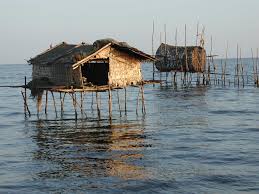
Cambodia Flag and Fast Facts | ||
 | Population 13,329,000 Capital Phnom Penh; 1,157,000 Area 181,035 square kilometers (69,898 square miles) Language Khmer, French, English Religion Theravada Buddhist | Currency riel Life Expectancy 56 GDP per Capita U.S. $1,600 Literacy Percent 70 |
Two Buddhist monks relax in the ruins of Bayon Temple. The site is just one of many wonders at Angkor—ancient capital of the Khmer Empire.
Photograph by W.E. Garrett
- Khmers have called their country Kampuchea (usually rendered Kambuja), since the l6th century. The name is derived from the word kambu-ja, meaning those born of Kambu (a figure of Indian mythology), which was first used to refer to the people of Cambodia in the 10th century. The Portuguese Cambodia and French Cambodge from which the English name Cambodia is derived, are adaptations of " Kampuja".
- History of Cambodia:
Human settlement in Cambodia dates back at least 7,000 years, and probably much farther.
- FOOD
Cambodian food is closely related to the cuisines of neighbouring Thailand and Laos, and to a lesser extent, Vietnam, but there are some distinct local dishes. In the growing number of restaurants in Phnom Penh and Siemreap, you will find excellent Chinese and Vietnamese dishes but it is the local dishes which are often the best prepared and most interesting. Rice is the principal staple and and Battanbang Region is the country's rice bowl. Most Cambodian dishes are cooked in a wok known locally as a chnang khteak.

Khmer Sour Soup
|
- The Tonle Sap River, which flows from Tonle Sap (Great Lake), reverses its direction twice a year. In the dry season the Tonle Sap River flows into the Mekong River and during the rainy season the floodwaters of the Mekong flow back into the Tonle Sap.

- Cambodia's first bridge across the Mekong River opened in 2001 linking the east and west of the country.
- Angkor Wat, known as the Eighth Wonder of the World, was built by King Suryavarman II (1131 to 1150). The city of Angkor Thom and the Bayon (temple) were built by King Jayavarman VII (1181 to 1220).



No comments:
Post a Comment